Tag: surrogate-modelling
-
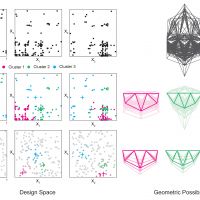 Designing with data: moving beyond the design space catalogNathan Brown and Caitlin Mueller, ACADIA, 2017
Designing with data: moving beyond the design space catalogNathan Brown and Caitlin Mueller, ACADIA, 2017Design space catalogs, which present a collection of different options for selection by human designers, have become commonplace in architecture. Increasingly, these catalogs are rapidly generated using parametric models and informed by simulations that describe energy usage, structural efficiency, daylight availability, views, acoustic properties, and other aspects of building performance. However, by conceiving of computational methods as a means for fostering interactive, collaborative, guided, expert-dependent design processes, many opportunities remain to improve upon the originally static archetype of the design space catalog. This paper presents developments in the areas of interaction, automation, simplification, and visualization that seek to improve on the current catalog model, while also describing a vision for effective computer-aided, performance-based design processes in the future.
-
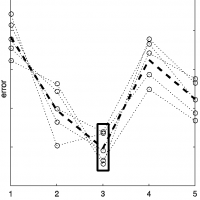 Data-driven approximation algorithms for rapid performance evaluation and optimization of civil structuresStavros Tseranidis, Nathan Brown, and Caitlin Mueller, Automation in Construction: Special Issue "BIG DATA IN CIVIL ENGINEERING", 2016
Data-driven approximation algorithms for rapid performance evaluation and optimization of civil structuresStavros Tseranidis, Nathan Brown, and Caitlin Mueller, Automation in Construction: Special Issue "BIG DATA IN CIVIL ENGINEERING", 2016This paper explores the use of data-driven approximation algorithms, often called surrogate modeling, in the early-stage design of structures. The use of surrogate models to rapidly evaluate design performance can lead to a more in-depth exploration of a design space and reduce computational time of optimization algorithms. While this approach has been widely developed and used in related disciplines such as aerospace engineering, there are few examples of its application in civil engineering. This paper focuses on the general use of surrogate modeling in the design of civil structures and examines six model types that span a wide range of characteristics. Original contributions include novel metrics and visualization techniques for understanding model error and a new robustness framework that accounts for variability in model comparison. These concepts are applied to a multi-objective case study of an airport terminal design that considers both structural material volume and operational energy consumption.
-
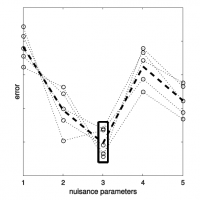 Approximation algorithms for rapid evaluation and optimization of architectural and civil structuresStavros Tseranidis, MIT SM thesis, 2015
Approximation algorithms for rapid evaluation and optimization of architectural and civil structuresStavros Tseranidis, MIT SM thesis, 2015This thesis explores the use of approximation algorithms, sometimes called surrogate modelling, in the early-stage design of structures. The use of approximation models to evaluate design performance scores rapidly could lead to a more in-depth exploration of a design space and its trade-offs and also aid in reducing the computation time of optimization algorithms. Six machine-learning-based approximation models have been examined, chosen so that they span a wide range of different characteristics. A complete framework from the parametrization of a design space and sampling, to the construction of the approximation models and their assessment and comparison has been developed. New methodologies and metrics to evaluate model performance and understand their prediction error are introduced. The concepts examined are extensively applied to case studies of multi-objective design problems of architectural and civil structures. The contribution of this research lies in the cohesive and broad framework for approximation via surrogate modelling with new novel metrics and approaches that can assist designers in the conception of more efficient, functional as well as diverse structures.
-
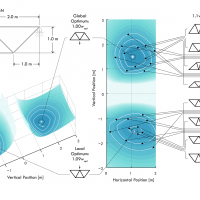 Computational exploration of the structural design spaceCaitlin Mueller, MIT PhD Dissertation, 2014
Computational exploration of the structural design spaceCaitlin Mueller, MIT PhD Dissertation, 2014This dissertation focuses on computational strategies for incorporating structural considerations into the earliest stages of the architectural design process. Because structural behavior is most affected by geometric form, the greatest potential for structural efficiency and a harmony of design goals occurs when global formal design decisions are made, in conceptual design. However, most existing computational tools and approaches lack the features necessary to take advantage of this potential: architectural modeling tools address geometry in absence of performance, and structural analysis tools require an already determined geometrical form. There is a need for new computational approaches that allow designers to explore the structural design space, which links geometric variation and performance, in a free and interactive manner. The dissertation addresses this need by proposing three new design space strategies. The first strategy, an interactive evolutionary framework, balances creative navigation of the design space with a focus on performance. The original contributions of this strategy center on enhanced opportunities for designer interaction and control. The second strategy introduces structural grammars, which allow for the formulation of broad and diverse design spaces that span across typologies. This strategy extends existing work in geometry-based shape grammars by incorporating structural behavior in novel ways. Finally, the third strategy is a surrogate modeling approach that approximates the design space to enable fast and responsive design environments. This strategy contributes new ways for non-experts to use this machine-learning-based methodology in conceptual design. These three complementary strategies can be applied independently or in combination, and the dissertation includes a discussion about possibilities and techniques for integrating them. Finally, the dissertation concludes by reflecting on its potential impact on design in practice, and by outlining important areas for future work. Key words: conceptual structural design, design space exploration, structural optimization, interactive evolutionary algorithm, structural grammar, surrogate modeling, structural design tools
-
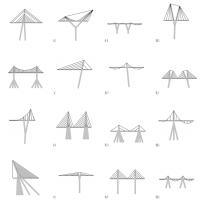 An integrated computational approach for creative conceptual structural designCaitlin Mueller and John Ochsendorf, Proceedings of the International Association for Shell and Spatial Structures (IASS) Symposium 2013, 2013
An integrated computational approach for creative conceptual structural designCaitlin Mueller and John Ochsendorf, Proceedings of the International Association for Shell and Spatial Structures (IASS) Symposium 2013, 2013This paper introduces a new computational approach for creative conceptual structural design, synthesizing an interactive evolutionary framework, a structural grammar strategy for trans-typological design, and a performance-focused surrogate modelling technique. By developing and integrating these three strategies into a unified design approach, this research enables architects and structural designers to explore broad ranges of conceptual design alternatives in an interactive way.
-
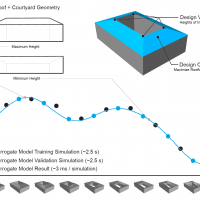 Surrogate modeling algorithms for conceptual designResearch, 2014 - Present
Surrogate modeling algorithms for conceptual designResearch, 2014 - PresentThis project investigates the use of surrogate modelling algorithms (sometimes called machine learning or approximation algorithms) for providing rapid performance evaluation in the conceptual design of buildings and large-scale structures. Such algorithms achieve substantially increased speed by substituting computationally expensive performance simulations with low fidelity statistical regression models. By deploying such techniques, designers are able to explore a design space thoroughly in real-time, run optimization routines, and evaluate many alternatives in a fast and efficient manner.


